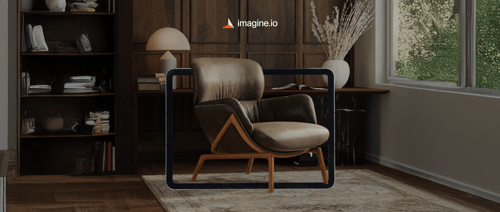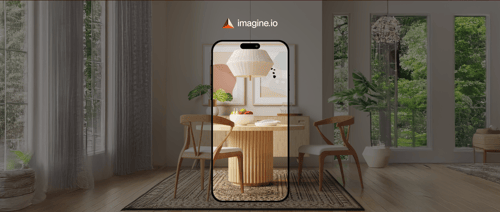If you run a WooCommerce store, you already know how challenging it can be to show your products in a way that feels real to customers. Photos help, videos help… but they still leave buyers guessing:
- “Will this color look good?”
- “What if I choose a different finish?”
- “Does the size really match my space?”
- “Will it look the way I imagine?”
Today’s shoppers expect more clarity, more control, and more confidence before they click Buy Now. This is exactly where a 3D product configurator becomes a business superpower.
In this blog, we’ll walk through:
- Why your WooCommerce store needs a product configurator
- What makes a good product configurator
- Step-by-step how to integrate one
- And how imagine.io makes the whole process simple, fast, and business-friendly
Let’s get into it.
Get the latest updates straight to your inbox.
By clicking sign up you'll receive occasional emails from imagine.io. You always have the choice to unsubscribe within every email you receive.
Why Your WooCommerce Store Needs a 3D Product Configurator
Today’s online shoppers expect more than static photos—they want clarity, confidence, and the ability to customize. A 3D product configurator gives your WooCommerce store exactly that: an interactive, trust-building experience that turns browsing into buying.
Here’s why it matters:
1. Your customers want to visualize before they buy
For high-involvement purchases—furniture, home décor, mattresses, modular units, appliances, or custom accessories—customers don’t want surprises. They want to see exactly what they’re getting. A 3D configurator allows them to:
- Rotate and explore the product from every angle
- Change colors and materials
- Switch finishes or patterns
- Adjust sizes, dimensions, and layouts
- Add/remove components
- Preview the product in their actual space using AR
The more time they spend interacting with the product, the more confident (and emotionally invested) they become. That confidence directly influences purchase decisions.
2. You reduce returns — dramatically
Most returns happen because the final product doesn’t match customer expectations. A configurator solves this by showing shoppers a realistic, customized version of the product before they buy.
When people know precisely how something will look, fit, and function, they make fewer mistakes—resulting in significantly fewer returns and happier customers.
3. You eliminate the chaos of managing hundreds of product photos
If you sell 10 products with 10 color options, you need 100 photos. Add finishes, sizes, fabric types, or hardware? Your photo count jumps to thousands—expensive to shoot and nearly impossible to manage.
A configurator replaces all of that. One digital model can generate infinite combinations, instantly and automatically. No photoshoots. No retakes. No storage nightmare. It streamlines your operations while providing customers with a better browsing experience.
4. You position your brand as modern and customer-first
3D and AR aren’t “nice-to-have” anymore—customers expect interactive shopping experiences. When your WooCommerce store offers that level of sophistication, you immediately stand out from competitors still using static catalogs. A configurator shows that your brand is innovative, trustworthy, and committed to helping shoppers make better decisions.
5. You increase conversions
People love products they can personalize. When shoppers interact with options, explore variations, and essentially “design” their version of the product, they feel ownership. This emotional connection leads to:
- Higher add-to-cart rates
- Longer time on site
- Lower hesitation
- Better conversion ratios
Simply put, a product configurator isn’t just a visual upgrade—it’s a revenue engine that drives higher sales with fewer returns.
What Makes a Good Product Configurator? (Business Owner Checklist)

Before you add any configurator to your WooCommerce store, make sure it enhances the shopping experience—not complicates it. Here’s a simple checklist to help you choose the right one.
1. Speed
A great configurator should load instantly. Slow 3D tools increase bounce rates and frustrate shoppers. Speed is especially important on mobile networks. Platforms like imagine.io use CDN hosting, optimized assets, and lazy loading to deliver a fast, seamless experience—even with heavy 3D models.
2. Realistic Materials & Lighting
The quality of your visuals determines whether customers trust what they’re seeing. Wood should look like actual wood grain, metal should reflect light naturally, and fabrics should feel textured. High-quality PBR materials and realistic lighting dramatically improve perceived product value and reduce hesitation.
3. Unlimited Variation Support
Your configurator needs to scale with your catalog. If you offer:
- 10 color options
- 20 fabrics
- 5 handle designs
- 3–4 size variants
- Multiple finishes or hardware choices
…it should handle all combinations smoothly, without slowing down your site. A strong configurator can generate unlimited variants from a single 3D model—no extra photos or plugins needed.
4. Rule-Based Logic
This is one of the most important features. A good configurator should prevent customers from selecting invalid or unavailable combinations. For example:
- “Leather is available only in the Premium model.”
- “Drawer add-on works only for sizes above 48 inches.”
- “Selecting an extended headboard adds ₹2,000 to the final price.”
This logic ensures customers see only what’s possible and accurate, reducing confusion, support tickets, and cart abandonment. This is where imagine.io truly stands out—all pricing rules, dependencies, and product logic can be built right into the 3D experience.
How to Add a 3D Product Configurator to Your WooCommerce Store

Adding a 3D product configurator isn’t complicated—especially when you break it down into practical steps. Here’s exactly how business owners can do it without touching complex code.
Step 1: Upload or Create Your 3D Model
You’ll start with the core of your configurator: the 3D model.
You can either:
- Upload existing 3D files such as GLB, FBX, USDZ, and more
- Or create brand-new 3D models using a platform like imagine.io
If you don’t have 3D models at all, imagine.io’s team can build them for you—accurately, quickly, and optimized for web performance. This ensures your configurator feels realistic and loads fast.
Step 2: Configure Your Product Options
Next, you’ll define what shoppers can customize. These options depend on your product category, but often include:
- Colors
- Patterns
- Texture finishes
- Frames or bases
- Dimensions
- Mattress layers
- Upholstery or fabric upgrades
- Drawers, legs, lighting, or add-on accessories
A strong configurator lets you set up:
- Pricing rules (e.g., premium fabric adds ₹1,500)
- Conditional logic (e.g., drawers only allowed above 48 inches)
- Default viewing angles
- Hotspots or information labels (optional)
This step is where the configurator becomes interactive and genuinely useful for buyers.
Step 3: Generate the WooCommerce Embed Code
Once the configurator is ready, the platform will generate an embed code for your store. With imagine.io, you can choose from:
- A shortcode for WooCommerce
- An iframe
- A block for Elementor or Gutenberg
- API integration (for advanced or custom themes)
This embed code is lightweight, clean, and won’t slow down your site.
Step 4: Add It to Your Product Page
Now, open your WooCommerce dashboard → go to the product you want to update → click Edit.
Paste the embed code in the section where you want the configurator to appear:
- At the top of the product page
- Inside the image gallery
- Or in a custom “Customize Your Product” tab or block
Click Update, and your configurator goes live instantly.
Step 5: Test Across All Devices
Before customers interact with it, make sure everything works perfectly.
Test your configurator on:
- Mobile
- Desktop
- Tablet
- Different browsers
- Different internet speeds
Check for:
- Load speed
- Variation accuracy
- Pricing updates
- AR functionality
- Responsiveness
- Touch gestures on mobile
With imagine.io, you get a built-in preview panel to test all of these before publishing—making it easy to ensure a flawless customer experience.
How imagine.io Makes This Incredibly Simple for Business Owners

imagine.io is designed for business owners who want the power of 3D without the technical headaches. You don’t need coding, developers, or complicated plugins—everything works through a simple drag-and-drop interface, and your configurator can go live in minutes.
-
No coding or complex setup: Just upload, configure, and embed.
-
Fast performance: All 3D assets are hosted on imagine.io’s CDN, keeping your WooCommerce site lightweight.
-
Works with every theme: Elementor, Divi, Gutenberg, or custom builds—it all fits seamlessly.
-
Smart product logic: Perfect for furniture, mattresses, and modular items where rules and pricing matter.
-
3D + AR in one viewer: Customers can rotate, customize, and place products in their room instantly.
-
Easy to update: Change materials or variants anytime without editing your website again.
In short, imagine.io removes the technical barriers so you can offer a premium 3D shopping experience with zero friction.
Final Thoughts
If you sell products that customers want to personalize, measure, compare, or visualize in their own space, then a 3D product configurator isn't just a nice-to-have—it's a growth engine.
Stores that adopt interactive 3D experiences consistently see stronger engagement, higher conversions, fewer returns, and a noticeable lift in customer satisfaction. It also elevates your brand, making your WooCommerce store feel modern, premium, and customer-first.
And the best part? Adding one doesn't have to be complicated. With imagine.io, the entire setup is plug-and-play, designed so business owners can launch a professional 3D configurator without technical effort or development costs.
Ready to Upgrade Your WooCommerce Store?
If you want to see exactly how a 3D product configurator can work for your catalog and your customers, talk to our experts— they'll guide you through it step by step.


.gif?width=1296&height=1296&name=Untitled%20design%20(8).gif)



.png?width=500&name=How%20to%20Add%20a%203D%20Product%20Configurator%20to%20Your%20WordPress%20Website%20(Complete%20B2B%20Guide).png)
















%20(1).png?width=500&name=Why%20Exploded%20Mattress%20Views%20Matter%20(And%20How%20to%20Generate%20Them)%20(1).png)
.png?width=500&name=Best%20Shopify%20Product%20Configurator_%20How%20to%20Choose%20the%20Right%20One%20(2).png)
.png?width=500&name=Why%20Exploded%20Mattress%20Views%20Matter%20(And%20How%20to%20Generate%20Them).png)



.png?width=500&name=Best%20Shopify%20Product%20Configurator_%20How%20to%20Choose%20the%20Right%20One%20(1).png)







.png?width=500&name=How%203D%20Rendering%20Can%20Make%20or%20Break%20Your%20Industrial%20Design%20Pitch%20(1).png)








%20with%20Digital%20Twins%20and%203D%20Visualization.png?width=500&name=Optimizing%20Your%20Digital%20Asset%20Management%20(DAM)%20with%20Digital%20Twins%20and%203D%20Visualization.png)




.png?width=500&name=Styling%20Home%20Decor%20for%202025_%20From%20Global%20Influences%20to%20Playful%20Personalization%20(1).png)

